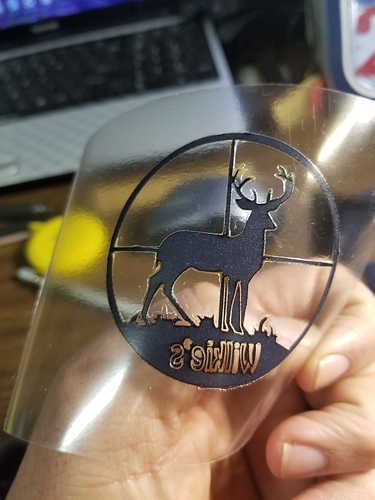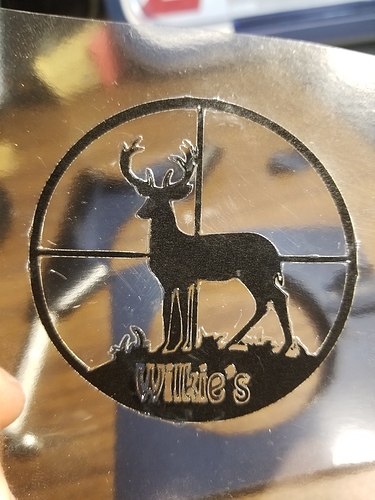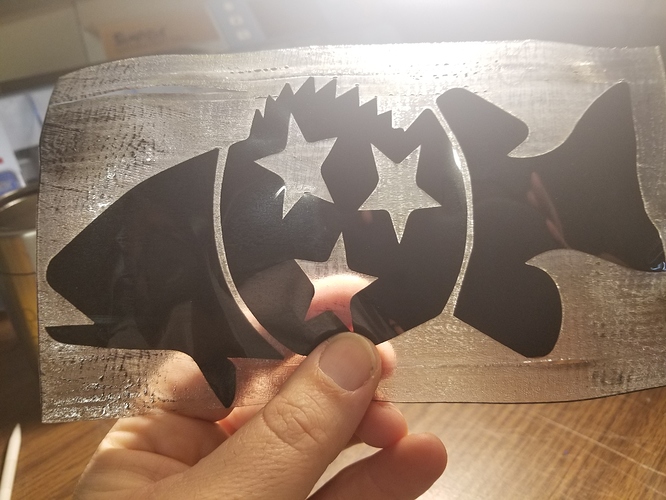I don’t do FB much at all, but today while looking for some DIY rotary plans I ran across a post on a laser group that they used their laser to cut/engrave a design onto heat transfer vinyl. I use a brother scan and cut to cut out design to heat press on shirt, but it doesn’t like to cut out little designs good. Anyway a lady in that group said she uses Siser Easyweed HTV on her laser, it doesn’t contain any PVC. This is a game changer for me, I can do numerous of the same design at one. I can’t wait to get home today and try it. I’ll report back…
Yep it’s polyurethane based so definitely laser safe. Interesting.
I’ve got to figure out the settings to engrave on it, then should be golden. Also, would think I could cut the areas out that I don’t need and there wouldn’t be any weeding. Save ton of time.
1st run…I cut it at 100 speed and 13% pwr on my 60 watt. Everything came out fine, exact the words. Still have some playing to do.
Does this mean that heat transfer vinyl is not vinyl?
Siser Easy Weed is non PVC. Other brands can be PVC. This is just one that we know for sure is vinyl free.
Stahls makes some as well that is PVC-Free as well.
Josh, how hard was it to get the power right to cut the HTV yet avoid cutting through backing paper?
@Doug I ran that at 100 speed 13% pwr on my “60 watt” it still cut through the backing, which is fine. That’s what I was trying to do so that there wouldn’t be any weeding. I’m back in the garage to play some more, I’m going to engrave a design and see what it looks like.
This took 15 minutes to run, so it’s not very much of a time saver. Yes I could have cut it out on the plotter. I ran it scanned it at450mms 25% and cut it 100mms 18% pwr. It didn’t completely clean it, but had I just cut the design out it would have been fine. I’m going to look for a more intricate design and see how it goes.
I couldn’t be happier with the Stahl’s products. PVC-free and work great. Layerable and once it is heat pressed into the fabric, it’s durable, soft, and launders beautifully.
I know this is an old post, but wanted to clarify something for anyone curious. It’s the “C” in PVC that’s bad. A lot of things just labeled as “vinyl” are PVC. But like, as far as I know, EVA is safe to laser cut… and that’s Ethylene-Vinyl Acetate. It’s the chlorine gas that’s bad for humans (toxic) and machinery (causes corrosion).
How do you layer? Do you press one layer at a time?
I’ve been to a conference and sat in on a class that Stahl’s put on about this. There are two methods to do this. One is to do a vector “KISS Cut” of the design you are trying to do, leaving the backing intact, then you would need to weed the vinyl, just like you would if you used a cutter. However, you can do more intricate cutting than a regular cutter. The other is if you are doing a very detailed design, you can raster engrave out the parts that you don’t want to transfer to the shirt, again, leaving the backing intact. This eliminates the need to weed the design, but also takes longer. As with everything, there are trade offs with the two methods, or you can combine them together, vector cut some of the design, raster other parts out, etc.
It really depends on how detailed the cut is going to be. If it’s simple shape like a square or circle with no add details it would probably take less then 5min. Do keep in mind each laser is different depending on power and manufacture.
Also if the material is used for laser sometimes the laser manufacturer will have recommended setting. Our laser is a trotec and they have bunch of different material settings they recommend. We don’t usually use them but they could be useful as base for testing and helping understand about how much power and speed should be use.
I’ve lasered a few heat-press or thermal shirt logos for customers, BUT, have found in the end, that using the plotter ‘the old way’ is more reliable - because, there’s no dust, smoke or or contaminant to potentially affect adhesion, and you don’t risk losing it all if you accidentally laser right through the carrier backing. (and there are times when it can be useful to laser right through- to save some weeding)
PU - polyurethane- is laser-safe and many heat-transfer ‘vinyl’ films are made from PU
Has anyone tried this with a 20W laser? If so, what are the settings that worked best. I’ve been trying, but no success.
Steve, I know this is very old post. But I was wondering if you remember from the conference if they talk about how to do ( set up on your computer program - eg lightburn) the raster engrave method.
To raster engrave, set up LightBurn just like you do to do any other raster engraving. All you are doing is burning away the HTV from the carrier sheet in all the areas that you don’t want to transfer to a shirt or whatever. Just burn it away instead of having to manually weed it out. No magic.


